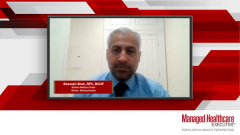
Oral and Topical Therapies for Atopic Dermatitis
An overview of topical and oral therapies used to treat mild-to-moderate atopic dermatitis.
Episodes in this series

Peter A. Lio, M.D.: For mild to moderate disease, we’re seeing some new innovations. The newest thing, which came out in 2016, was crisaborole. That was our first new, big treatment in 10 or 15 years. That was exciting and designed for mild to moderate disease. That’s still on the market and just got an indication down to three months of age, which is also exciting because a lot of the things cap out at two years of age and some things are for adults only. This is cool to have something for the baby range.
There’s a bunch of things being studied. There are other phosphodiesterase 4 inhibitors. There’s a new type of medicine that’s never been put out before, called tapinarof. That’s an aril hydrocarbon receptor modulator. I’m not sure if that will be for moderate to severe or for mild to moderate. There are all sorts of new barrier creams and moisturizers. There are a lot of new things on the market and there’s a whole bunch of work on the microbiome. I put all these things in this mild to moderate group because they’re relatively safe and accessible.
The second part will be, what about the moderate to severe? Those are the patients who are suffering the most. There we also have some exciting stuff. But with more power comes more responsibility, and the sword cuts both ways. We have some very powerful treatments like the oral JAK inhibitors, which are super exciting. They’ve been held up by the FDA, but I do expect all of them to get approval at some point. Those are extremely powerful and will help some of our most severe patients, which we have seen in studies.
We also have a new topical JAK inhibitor that just got approved a few weeks ago: topical ruxolitinib. That’s exciting for moderate to severe patients, and smaller body surface areas can be really powerful. There are also some new biologic agents. Dupilumab was our first biologic. It came out for adults only in March 2017 in the United States. Now it has been approved down to six 6 years of age, which is exciting. There are even data down to six 6 months of age. We’ll see if that approval happens. We’re excited, but there are other biologics, such as tralokinumab, lebrikizumab, and nimotuzumab. There are a bunch of things coming down the line. It’s an incredibly exciting time for even our most severe patients having nonsteroidal options too because many patients have burned out with topical and systemic steroids, and appropriately so. We don’t want to keep throwing steroids at these patients because they can cause a host of issues.
In broad strokes, generally we want to pick things that are less risky, have fewer side effects, and have fewer issues than the disease we’re treating. For these mild or moderate patients, we’re trying to start with more gentle things that have lower profiles of risk. There are a couple of things we understand. Moisturizers—usually over-the-counter ones, but these prescription devices are also as a device category—have been shown to help atopic dermatitis probably of all severities, but they’ve largely been studied in mild to moderate groups. They’re incredibly affordable for most patients. They’re very accessible in general, and their side-effect profiles are mild to minimal when we think about this.
The research and the barrier have come a long way with understanding about ceramides, specialized fats in the skin, and even more exotic things like finding ways to induce natural moisturizing factor, which helps with the acid mantle and pH control. Even some of the newest ones can directly affect the microbiome. We have some topical probiotic products. We have some products that contain enzymes that can actually kill Staphylococcus aureus. We have hypochlorous acid and diluted bleach-type preparations as well.
We also have some new anti-itch products. Some are old ones that have been repackaged. Some of the larger over-the-counter brands have used things like pramoxine again. This can be very helpful for soothing itch and pain because technically pramoxine is an anesthetic, so it helps with both itch and pain for these patients. Then there are even some newer things being developed. In general, for these mild to moderate patients, we want to keep the risks to treatments very low and the benefits modest or better. They can help with our PDE4 inhibitors, for example; they’re very safe. They don’t have a black box warning, but they often sting and burn. That’s a problem. Especially in a kid, if they have an open sore and we put this on and it stings and burns, not only might it ruin it for that medicine, but they’re also saying, “I don’t want that medicine.” Sometimes it can be generalized, and they’ll say, “I don’t want any medicine. Don’t put anything on me.” We’ve seen this happen where they get a phobia of any treatment. That can make life very difficult. Even though the side effects tend to be mild, we want to be mindful of them and careful because we don’t want to burn those bridges.
Transcript edited for clarity.
Newsletter
Get the latest industry news, event updates, and more from Managed healthcare Executive.




















































